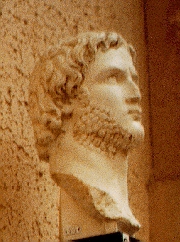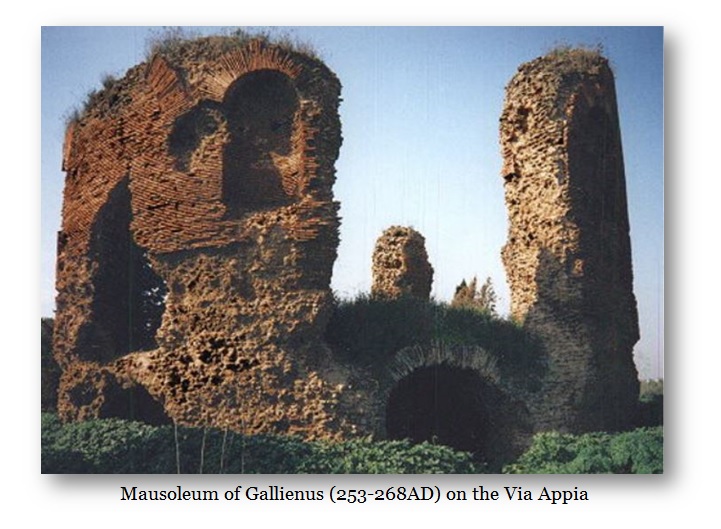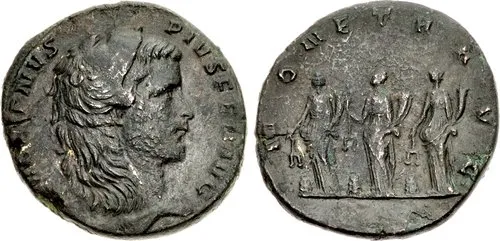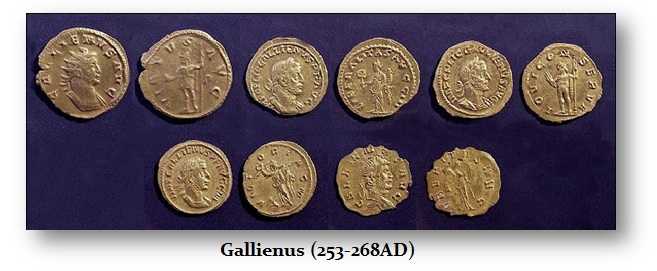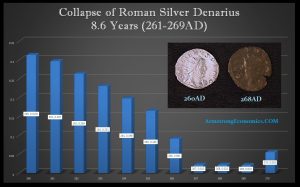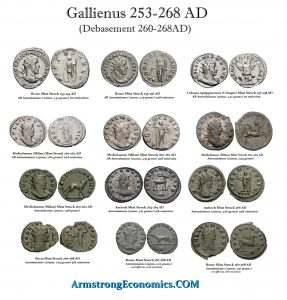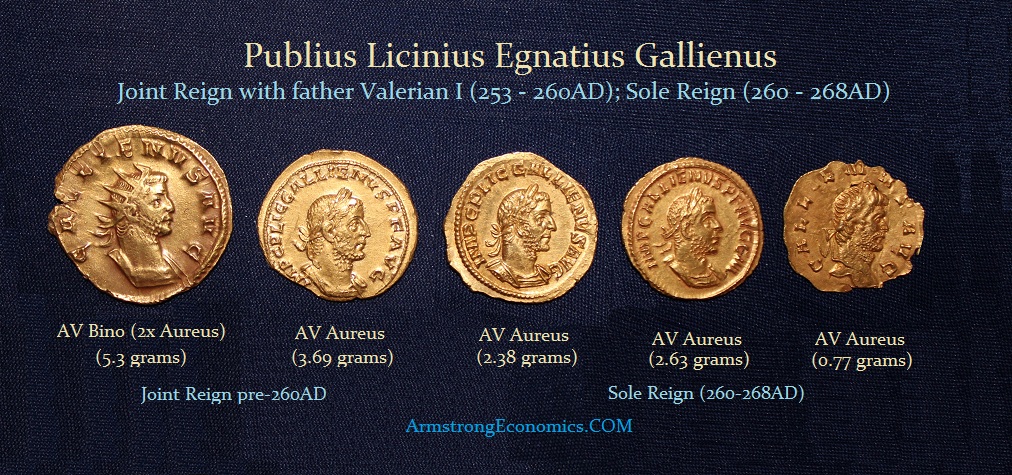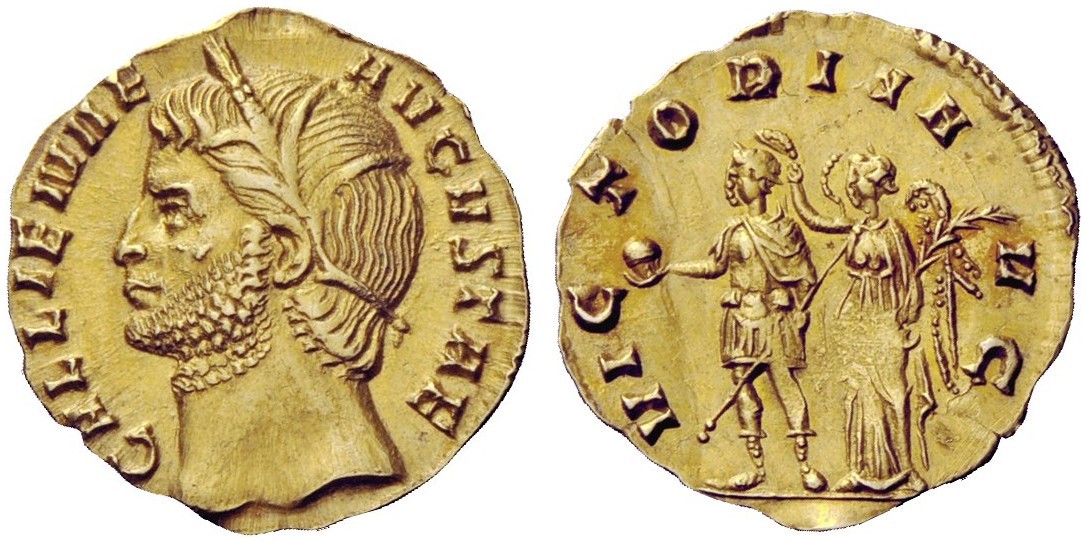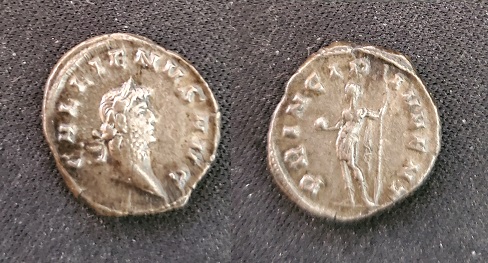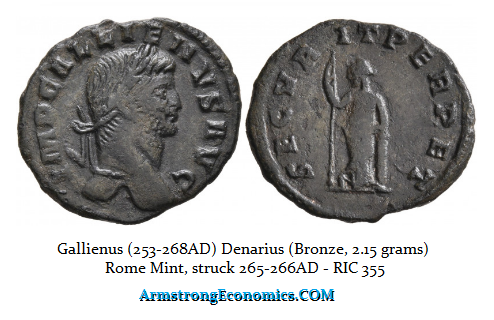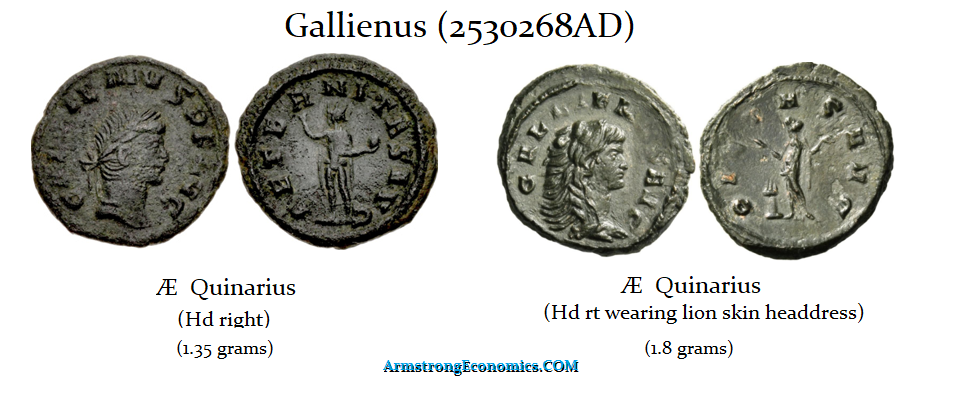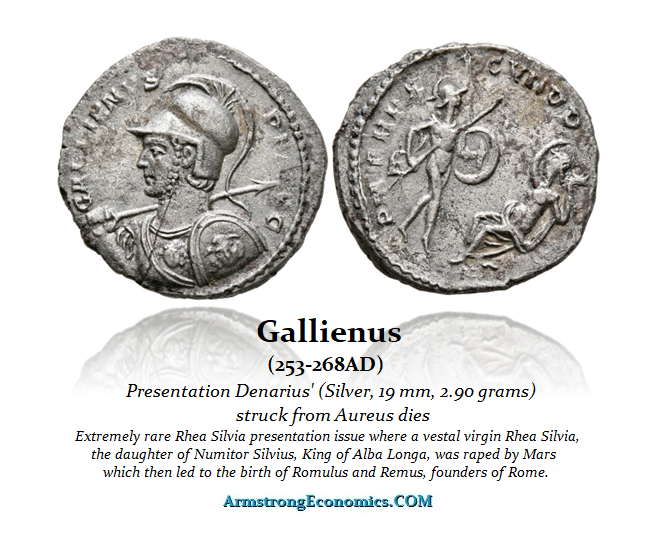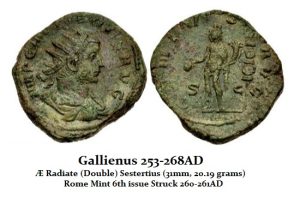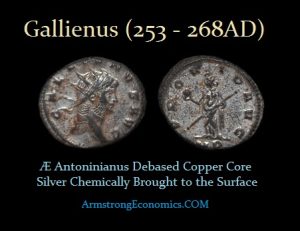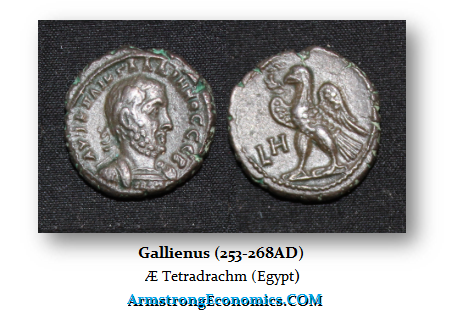Gallienus
253 – 268 AD
Publius Licinius Egnatius Gallienus was the son of the emperor Valerian I. Gallienus was raised to the rank of co-emperor (Augustus) soon after his father was hailed Augustus by his troops. At the same time, Gallienus’s son, Valerian II, was given the rank of Caesar. In 254 AD, Gallienus was charged with the defense of the Rhine frontier before his father’s departure from Rome to deal with the Persians in the East. In 255 AD, his eldest son Valerian II died and his youngest son, Saloninus, was then given the rank of Caesar. Gallienus was married to Cornelia Salonina who he raised to the rank of Augusta, considering the fact that his mother, Mariniana, died before he or his father had become joint emperors leaving the position of Augusta vacant.
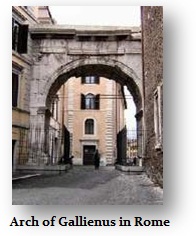 Gallienus was quite successful at first against the German tribes for which his Arch of Triumph still stands today. With his father’s departure for the East in 256 AD, the responsibility for administering the Western provinces fell to Gallienus. With the capture of his father by the Persians in 260 AD, Gallienus inherited the throne as the sole ruler of the Roman Empire. He was then raised to the rank of co-emperor his youngest son Saloninus in 259 AD.
Gallienus was quite successful at first against the German tribes for which his Arch of Triumph still stands today. With his father’s departure for the East in 256 AD, the responsibility for administering the Western provinces fell to Gallienus. With the capture of his father by the Persians in 260 AD, Gallienus inherited the throne as the sole ruler of the Roman Empire. He was then raised to the rank of co-emperor his youngest son Saloninus in 259 AD.
With the capture of his father, the Roman Empire fell into a serious political crisis. Gallienus himself responded quite valiantly considering the embattled state of the Empire at the time. One of his surprising political actions was to reverse his father’s anti-Christian edicts, which actually ushered in a period of religious tolerance that lasted for the most part until the reign of Diocletian and Maximianus nearly 40 years later.
Between 260 and 262 AD, at least 7 internal usurpers laid claim to the throne. With the economic conditions of Rome collapsing and hyperinflation running uncontrolled, the Roman Empire suffered from both internal conflicts as well as external invasions not to mention famine and plagues.
Much of the Roman Eastern provinces were lost to the control of Odenathus of Palmyra. In 260 AD, a Gallic rebellion led by Postumus, the commander of the Rhine legions, resulted in the breakaway of the Western provinces of Gaul, Spain, and Britain. In 260 AD, the Eastern army of Valerian I, what was left of it, rallied behind Macrianus and proclaimed him to be emperor. After halting the advance of the victorious Persian army, Macrianus and his son Quietus marched against Gallienus but were defeated in Illyrucum by the competent general Aureolus. In Upper Pannonia, Regallianus seized power declaring himself to be Augustus following the defeat of Ingenuus who had led the first rebellion of the Danube region. While Ingenius was also defeated by Aureolous, Regallianus‘ uprising was short-lived since he was murdered by his own troops. These usurpers and others were recorded as part of the Thirty Tyrants in the Historiae Augusta.
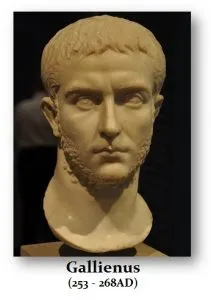 Gallienus was forced to deal with the senators of Rome by restricting them from holding any military command. This was in part sparked by the fact that several senators had often supported some of the usurpers. Consequently, Gallienus was much disliked by the senate and was often blamed by them for the terrible economic condition of the state. This led many historians to paint a very biased view of Gallienus instead of the emperor who did his best to defend the empire.
Gallienus was forced to deal with the senators of Rome by restricting them from holding any military command. This was in part sparked by the fact that several senators had often supported some of the usurpers. Consequently, Gallienus was much disliked by the senate and was often blamed by them for the terrible economic condition of the state. This led many historians to paint a very biased view of Gallienus instead of the emperor who did his best to defend the empire.
The final straw for Gallienus came with the Gothic invasion in 268 AD. It was this invasion of the Goths from the Danube regions that prevented Gallienus from seriously addressing Postumus in Gaul and Palmyra in the East. The Goths had invaded Roman territory in 256, 262-263, and 267 AD. No doubt, these previous invasions contributed to the rising costs of government that chipped away at the monetary system of Rome. The invasion of 268 AD, was by far the biggest and most forceful attempt at taking the seat of power in Rome itself. This time the Goths joined forces with another tribe known as the Heruli from the Black Sea region. Gallienus valiantly marched against the invaders but was too late to prevent their sacking of Athens. Still, Gallienus managed to deliver a stunning defeat to their forces at the battle of Naissus.
While Gallienus was dealing with the Goths, his own general Aureolus had been left in Italy to defend against any attack by Postumus. Instead, Aureolus defected to Postumus and even proclaimed himself to be emperor in Gallienus’ absence. This new internal crisis forced Gallienus to leave the Goths to his generals and he marched back to Italy to confront Aureolus where he defeated his army at the battle of Pontirolo. Aureolus, however, fled to Milan and Gallienus launched the famous “Siege of Milan.” It was here where the embattled emperor was assassinated by his own generals in a conspiracy most likely involving Claudius II and Aurelian. Gallienus was buried in a modest tomb along the Via Appia several miles outside the city of Rome due to his unpopular status. It was Claudius II who convinced the Senate to deify him.
Medallion Depicting Gallienus as Hercules Saving the World
Titles and Powers, 253-268 AD
Yr Tribunician Power Consul 253 TR.P.
254 TR.P.II. COS.
255 TR.P.III. COS.II.
256 TR.P.IIII.
257 TR.P.V. COS.III.
258 TR.P.VI.
259 TR.P.VII.
260 TR.P.VIII.
261 TR.P.VIIII. COS.IIII.
262 TR.P.X. COS.V.
263 TR.P.XI.
264 TR.P.XII. COS.VI.
265 TR.P.XIII.
266 TR.P.xIIII. COS.VII.
267 TR.P.XV.
268 TR.P.XVI.
**Note: The coinage of Gallienus can be distinguished between his joint reign with his father (253-260 AD) than that of his sole reign (260-268 AD) by the title “AVGG” (joint reign) and AVG (sole reign).
Monetary System
Mints: Rome; Milan; Siscia; Cyzicus (?); Antioch
Obverse Legends:
GALLIENVS AVG
GALLIENVS P F AVG
IMP GALLIENVS AVG
IMP GALLIENVS P F AVG
IMP C P LIC GALLIENVS AVG
IMP C P LIC GALLIENVS P F AVG
Monetary Reform
Note: The coinage of Gallienus and his father Valerian I reflects the serious economic difficulties during his reign. The high cost of defending the empire had taken its toll and there is no better record for that than the coinage of the empire itself. Both the gold and the silver coinage reflect the great difficulties during this period as hyperinflation dominated the economy. The weight of the gold coinage varies so greatly, that at first glance it would appear as if there were no monetary standards whatsoever. The gold coinage is both irregular in size and weight. The range in weight for the gold coinage varies from as little as 2 grams to nearly 6 grams. It is clear that a double aureus was maintained, first being introduced by Caracalla briefly, and more formally by Trajan Decius (249-251 AD). However, specimens of the double aureus (as illustrated here) show a weight of 5.29 grams on average. This is slightly less in weight compared to the double aureus of Trebonianus Gallus at 5.67 grams. The aureus itself appears to have declined in weight fairly rapidly from 3.25 grams down to 2 grams. The wide variety in weights recorded by Roman Imperial Coinage reference, suggests that the decline in the monetary system was extremely rapid with perhaps the weight being reduced virtually monthly.
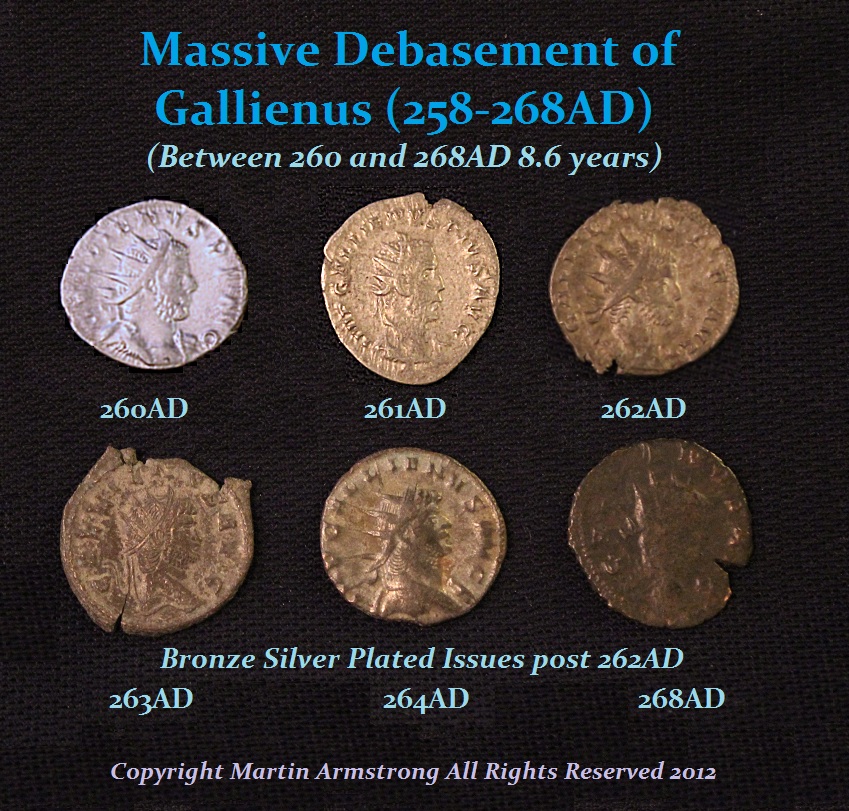
The silver Antoninianus begins with a weight of about 3.5 grams. Within the first two years of his reign, the weight of this coinage declined below 3 grams. The silver coinage began to decline in weight steadily between 257-258 AD. By late 259 AD, the silver content itself began to decline to drop below 40% becoming a light chocolate bronze coin thinly coated with a silver wash. Ultimately, silver virtually disappeared completely between 262-268 AD under Gallienus and the Antoninianus of this later stage had in fact been drastically reduced to the point that the coins were in fact mere bronze imitations thinly coated with a fine silver wash to keep up appearances (much like the withdraw of silver in modern times during the 1965-1968 period). Simultaneously, due to the fact that the once silver Antoninianus had become debased to the point of a mere bronze coin itself, the traditional bronze denominations of the sestertius, dupondius and as ceased to be minted. The bronze was being used to coin the much more valuable Antoninianus.
DEBASEMENT
Unlike the early forgers who would produce fakes by covering copper blanks with a sheet of silver on both sides and using heat to weld the two metals together, the method used by the Romans for plating bronze coins was chemical; whereby they understood that copper is easily etched away by certain acids and corrosive salts that will leave silver untouched.
The debasement using chemicals may have begun in Antioch (Syria) and then spread to the other mints. Rome appears to have been the worst which indicates that this was not an official policy. What we find in the surviving coinage is a great disparity among the known mints simultaneously of Rome, Milan, Siscia, Cyzicus (?), and Antioch.
How they accomplished this chemical process was to begin with a blank planchet which contained about 5% silver, the planchet was then dipped in a “pickle” solution of corrosive salts and acid. The copper was dissolved out from the surface, leaving a microscopically thin layer of pure, spongy silver on the surface. When the planchet was then heated and struck with the dies, the sponge-like silver was flattened down and spread across the surface of the coin.
The result was a brilliant silvery finish on the coin making the appearance as if it were silver. This silver layer would quickly wear off in circulation leaving the bronze appearance. This method was employed from the reign of Gallienus (253-268AD) which appears about 261AD after his father Valerian I (253-260AD) was captured by the Persians. This may also explain which it appears that this chemical method of silver plating began in Antioch in the region where Valerian was combating the Persians.
While the gold coinage was NOT debased, it was reduced in weight. We find gold coins of Gallienus which are nearly paper thin. It is extraordinary that they have even managed to survived.
DENOMINATIONS
AU DOUBLE Aureus (5.3-6.0 Grams)
AU Aureus (3.0-2.5 Grams)
AU Quinarius (0.77-1.5 Grams)
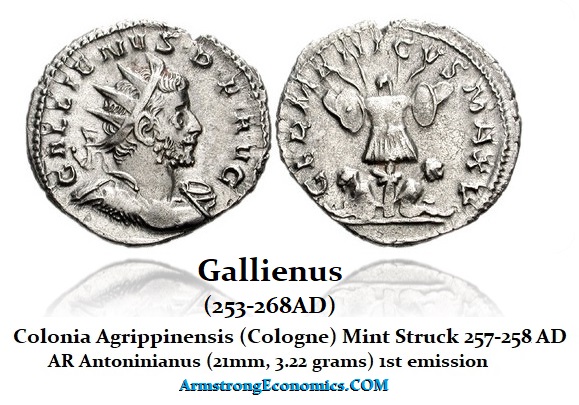
AR DOUBLE Antoninianus (8.0+ grams)
AR Antoninianus (5.23-3.5 grams)
DEBASED
Æ Denarius (2.15 grams)
- Æ Quinarius (1.35 grams)
- Æ Quinarius (Hd rt wearing lion skin headdress)
Presentation Silver Denarius
AR Denarius
Æ DOUBLE Sestertius (20.9 grams)
Æ Sestertius (15.9 grams)
Æ Dupondius
Æ As (8.3 grams)
Post-259 AD Inflationary Reform
AU Aureus (2.5-1.5 grams)
Æ HEAVY Antoninianus (silver-washed 5.32 grams)
Æ Billion Antoninianus (silver-washed 2.0-3.2 grams)
Æ Antoninianus (silver-washed 2.0-3.2 grams)
Æ Denarius
EGYPT
Æ Tetradrachm (Egypt)

